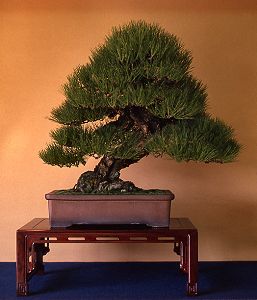
Kuro matsu, styled by Mitsuyasan.
Details and larger version
As regal as an emperor on his throne, Mitsuyasan sat on his workshop chair. His wife, Okusan (Mrs. of the house), retrieved a blender that had gone unused since the death of Ojiisan (Mitsuyasan's father) and placed the machine on the table in front of the bonsai master. I knew we weren't going to make Margaritas, so I kept one eye on the venture as I continued to thin the foliage on my momiju (Japanese maple).
A box about the size of a loaf of bread was placed next to the blender. In it were several hundred pieces of dried fish: head, tail, and all. It didn't take a rocket scientist to figure this one out. Pulverize the fish in a blender and you have the beginnings of bonsai no gohan (bonsai food). Unfortunately, I was only half right. When I heard the word oishi (tasty, delicious), I looked up to see Mitsuyasan chewing on a piece of pre-bonsai food.
I turned to the others in the room for reassurance that he was just joking, but their jaws was also working overtime trying to soften the seafood jerky. I was told it was daijabu (okay), but even the affirmative nod didn't convince me. However, when in Japan, do as the nihonjin (Japanese) do, so I went along with the program and followed the leader. Oishi it was not, but I have eaten worse. And so began my introduction to Japan, culinary and otherwise.
As an apprentice from Los Angeles, I could appreciate the changes in seasons that were foreign to me as a southern Californian. And in a bonsai master's workshop, I was continually astounded at the transformations that took place on bonsai of all levels of development. Unquestionably, the most refined trees I saw were displayed at the Kokufu bonsai show in Tokyo.

I was fortunate to watch, assist, and photograph the transformation of a beautiful goyo matsu (five needle pine) into a magnificent showpiece for Mitsuyasan to submit to the selection committee for the 68th Kokufu show.
The styling of a tree, which usually involves trimming of branches, wiring, and repotting, is done at least one or two years before the show. That leaves just the fine detail work to be completed one to two months before the judging. The 248 displays of the 68th annual show comprised only forty percent of the trees submitted for consideration.
This tree is owned by Umbarasan, who maintains it in his beautifully landscaped yard in the lovely old town of Odawara.

When we picked up the tree the previous fall, I had thought it looked terrific. But after an entire week of primping and pampering, the tree was spectacular.
The first and most consuming job was to clean the needles. This tree has fairly straight needles, but over time some of them break, bend, or droop. These undesirable needles give the tree a sloppy look which is unacceptable at show time.
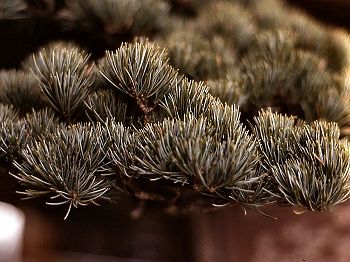
There are two basic approaches to removing pine needles. The most conservative is to cut off the unwanted needles with sharp hasami (scissors). By cutting most but not all of the needles from the branch, the bud at the base of the needle is left intact and there is a possibility of the bud developing into another branch.
The second method to removing needles is by pulling them out using fingers or pinsetto (tweezers). While this is usually a faster approach than cutting needles, you run the risk of damaging the branch. The bark of the goyo is thin and more delicate than other matsus. Also, the base of the five-needle cluster is rather large; when pulling out the needle clusters, there is the propensity of taking bark off in the process. If enough bark is removed, the branch dies.
Our goyo matsu was very full and lush. Most people who visit the Kokufu show would only notice the needles on the front of the tree. But the judges would examine this tree from all angles. Therefore, it was imperative that every damaged needle be removed. To maneuver scissors in this dense foliage would probably cause more damage than they'd remove. So the decision was made to remove unconforming needles with long, slender tweezers, which was the least intrusive choice.
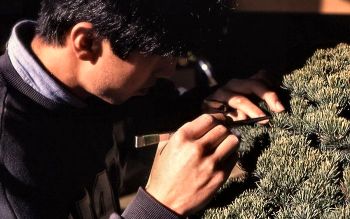
To minimize damage to the bark, the needles were pulled out one by one. This process was very successful, but took about four days to complete.
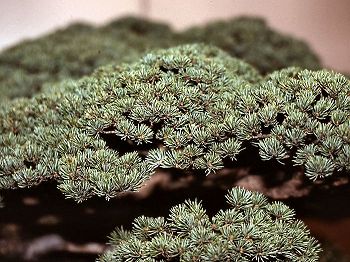
The pines have a softer wood than the junipers. Frankly, I was surprised at the number of pine that have jin and shari (exposed dead branches and trunk), because over time this can rot away. Our tree had been graced with the elegant jin and shari that give it an aged look. But a small portion of the shari in the main trunk began to rot. All the damaged wood was removed, which left an unsightly hole. The hole would retain water and continue the rotting process, so it was filled with cement. The pale grey color of the cement was very similar to the colors of the dead wood and I didn't notice the patch job at first. Although this was an acceptable and common way to repair the damage, it was an unacceptable flaw for a show tree. But when the flaw was properly camouflaged, no one was the wiser.
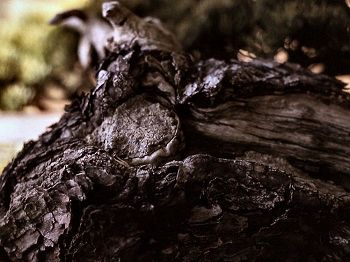
With the high humidity of Japan, koke (moss) will commonly grow on the trunks of trees. This tree had a little of the greyish mountain moss and lichen that is so attractive and desirable. The obvious camouflage was to extend this beautiful attribute over the cement. So one crisp January afternoon, Yochan, my sempai (senior colleague), made the trek to the nearby mountains in search of yama koke (mountain moss). He returned with the most interesting mix of lichen and moss that had the most interesting stalagmite type growth.
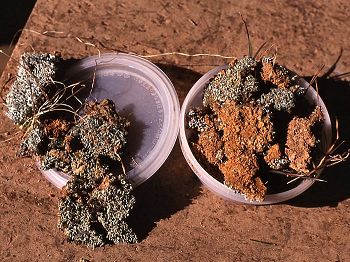
The dry red soil that accompanied it made a nice contrast, but it would have been a distraction on the bonsai, so it was scraped off before its application to cover the concrete plug.
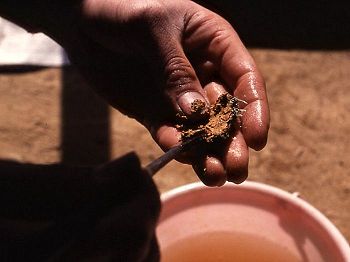
The glue to hold the moss to the trunk was a muck that Yochan made with moss, akadama dust, and clay. I don't know where he got the clay, but the akadama dust consisted of the fines that were saved when we screened akadama for potting bonsai. Yochan rubbed misu koke (water moss) which resembles sphagnum moss across a screen to shred it into small bits for incorporation into the muck.
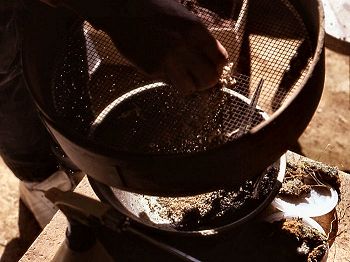
All three ingredients were mixed, and water was added to the powder. The resulting goo had the look and spreadability of chocolate frosting. Yochan moistened the circular concrete patch and surrounding shari. First, he covered the concrete.
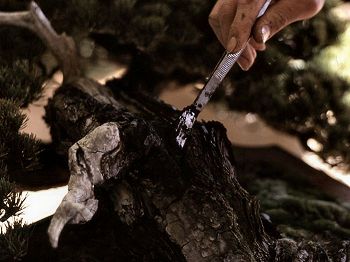
Then, he extended the muck along one line where shari met bark.
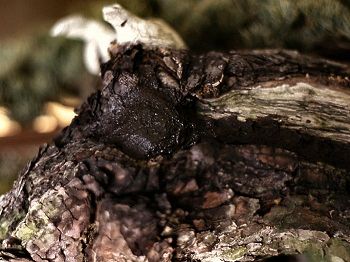
Once the concrete patch was covered with muck, moss and lichen were saturated with water.

As if fitting puzzle pieces together, Yochan carefully placed each piece into position.
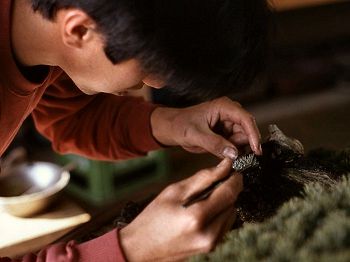
The moss, gently pressed into the muck, looked natural as it covered the cement and continued down the trunk along the line where bark met shari. The grayish moss harmonized with the needle color and was not a distraction.
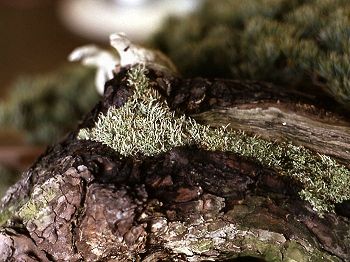
Next, Yochan addressed the soil surface. With the humidity in Japan and the slightly acidic soil, moss grows quite easily – except where dango (bonsai food balls; literally, "sweet dumplings") sit. Once the food was removed, brown polka dots disrupted the moss landscape.
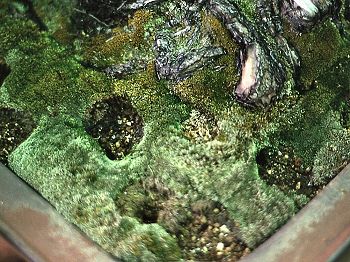
Yochan wasn't satisfied with simply filling the holes with more moss. Because of variations in moss color, there was a chance the repair job would look like green polka dots. So he removed some of the existing moss to make the replacement less uniform.
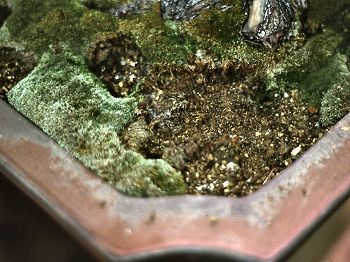
A variety of moss (color, shape, and texture) was applied to give character and interest as well as a natural effect. Both the moss and the soil surface were saturated with water. Then Yochan pressed irregular pieces of moss onto the soil. Very finely screened akadama was brushed into crevices to fill any gaps.
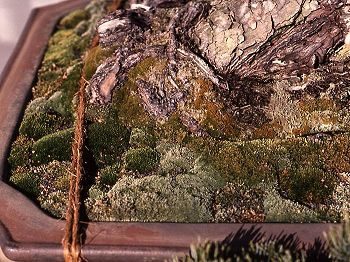
Finally, the pot was gently cleaned with a wet cloth and the bonsai was ship-shape for showtime. Yochan loaded the tree into the van along with six other magnificent bonsai. Three weeks before the 68th Kokufu show, Mitsuyasan drove four hours to Tokyo for the judging. This tree, along with two black pines and a Japanese maple, were accepted for display at the show.
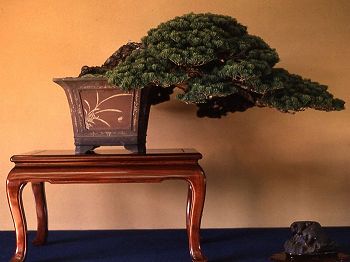
Once this tree had been primped and polished, I couldn't imagine it looking finer. However, a few days before the show, I woke to find a light dusting of snow had created a winter wonderland.
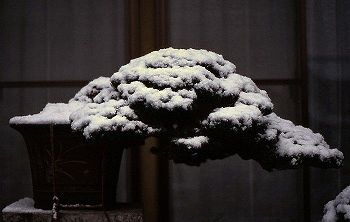
Everyone walked around the nursery to enjoy the glorious scene. Because the trees were winter-hardy and accustomed to nightly freezes, Mitsuyasan knew they'd be fine – all except for the goyo matsu. Just after I snapped the photo, Yochan was directed to wash off the snow and bring the tree into the workshop; Mitsuyasan didn't want to risk frost damage to its perfect needles.
The goyo matsu was one of many grand bonsai at the Kokufu show. But as far as I was concerned, it looked its finest wearing a blanket of snow – serene, majestic, and magical.
[ Top of page | Go back | Go forward | "An Apprentice in Japan" contents | Site contents | Home | ]